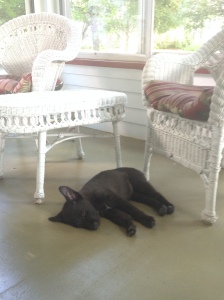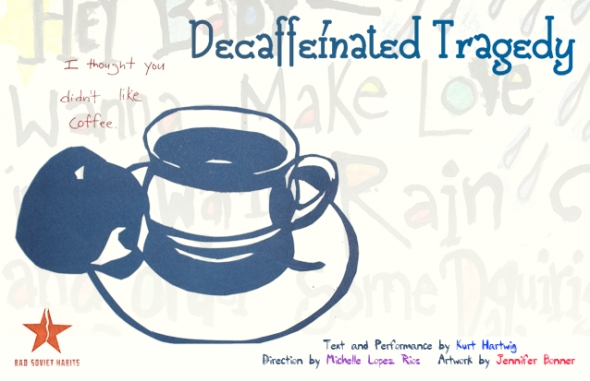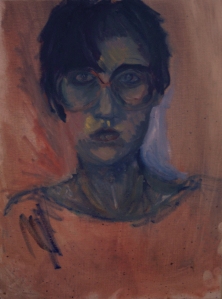Bestiary Home
In my general understanding, jinn (alternate spelling: djinn) are genies – specifically, the kinds of genies trapped in lamps that provide three wishes. Or instant death, depending on the story I was reading. Some spirits get cranky about how long they’ve been trapped, so don’t assume it’s all going to turn out perfect for the holder of the bottle.
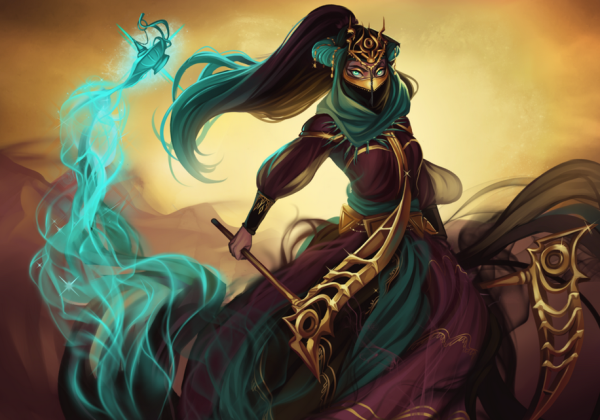
milkydayy at deviantart
So let’s start with that one stereotypical image and all of the things packed into it: the ethereal nature of jinn (gotta fit into that tiny lamp somehow), their magical power, their age. Those containers are old. No, let’s not start there. Let’s go back further. How did a being so powerful get locked into a bottle in the first place, or somehow tied to it at all? Even farther back – where did they come from at all?
Origin of the Jinn
For a second time, there is more to a question than meets the eye. Geographically, stories of jinn seem localized to the Near East. In pre-Islamic Arabian mythology, such spirits or spirit-like beings were probably worshipped. Unsurprisingly then, most of the visual inspiration is Arabian Nights inspired. Ahem. To greater and lesser degrees. Of course, “worship” nowadays comes in all kinds of flavors.  Given their slippery and intangible physical presence, not to mention a certain amount of cultural overlap and general similarity-of-being, it is not uncommon for people to make note of the similarities between the Arabic-language jinn and the Greek-language daemon, a kind of chthonic spirit. I’m not getting into daemons here – that’ll have to be a topic for another day – but it’s worth noting the connection.[1] We do have a fairly precise textual notation of how the jinn came into being, however, and that is the Qu’ran. In the 51st surah (this is a division of the Qu’ran – I take it to mean something like a chapter, but I’m out of my depth here), Zariyat 51:56 reads, “And I created the jinns and men, only for them to worship Me.” (See also this article.) In other words, jinn, like humans, were created to worship Allah. Like humans, jinn have a measure of free will. They can choose to be faithful or not. They can choose to be generous or not; also cruel, loving, merciful, gentle. They’re a lot like us in behavior, if not in essence. They are no more noble, no more base. That’s recipe for miracles or disaster – which, when you think about, is the exact danger of trying to wish for something from a jinni in most of the stories about them.
Given their slippery and intangible physical presence, not to mention a certain amount of cultural overlap and general similarity-of-being, it is not uncommon for people to make note of the similarities between the Arabic-language jinn and the Greek-language daemon, a kind of chthonic spirit. I’m not getting into daemons here – that’ll have to be a topic for another day – but it’s worth noting the connection.[1] We do have a fairly precise textual notation of how the jinn came into being, however, and that is the Qu’ran. In the 51st surah (this is a division of the Qu’ran – I take it to mean something like a chapter, but I’m out of my depth here), Zariyat 51:56 reads, “And I created the jinns and men, only for them to worship Me.” (See also this article.) In other words, jinn, like humans, were created to worship Allah. Like humans, jinn have a measure of free will. They can choose to be faithful or not. They can choose to be generous or not; also cruel, loving, merciful, gentle. They’re a lot like us in behavior, if not in essence. They are no more noble, no more base. That’s recipe for miracles or disaster – which, when you think about, is the exact danger of trying to wish for something from a jinni in most of the stories about them.
The Nature of Jinn
According to what I’ve found in online research, relying where I can on sources that seem plausibly familiar with the Qu’ran and Arabic (though yes, there’s a good chunk of Wikipedia in this research), there is an order in which sentient beings were created. First the angels, made from light. Second the jinn, made from smokeless fire (Qu’ran 15:26-27). Roughly two thousand years after the jinn, humanity. The jinn had been causing all kinds of mayhem, so Allah sent a troop of angels to beat them and cast them “to islands in the sea” (Remember this! It’s like foreshadowing!) One translation of the Arabic word “jinn” is “hidden from sight”[2], which goes some distance in explaining a jinni’s ethereal nature. They are not necessarily smoke-like so much as their natural shape is not physical in the same way ours is – to reiterate, they are not made from clay. Because they are not of the world that we perceive, I am classifying them within Otherworldly Creatures, though they are not in any way divine. They are powerful, though, no two ways about it.

Imam Ali and the Jinn
Their more fluid bodies suggest that they are not terribly limited in their physical bodies. In some textual sources[3], one frequently mentioned typology of jinn includes three categories: those that fly, those that take ugly shapes such as snakes or dogs, or those that take human form. A second three-tiered typology includes the amir, which is a jinn that resides amongst people (perhaps like the Scottish brownie?), the shaytan, which is a malicious jinni (note the similarity here between shaytan and the anglicized name Satan, which is not a coincidence), and an ifrit, which is stronger than a shaytan. Of these three, there is no moral bearing mentioned with regards to the amir or the ifrit. Rather than imply goodness, I suspect it is simply the case that those other two kinds of jinn are as complex as people, given to fits of rage, pique, or swayed by mercy and love. However, al Jahiz has something to say about this as well.
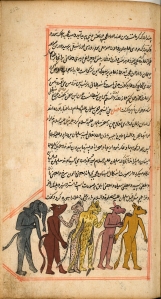
Jinn in an illuminated manuscript – I can no longer find the original link where I found this image.
Writing in the 9th century CE, al Jahiz was a celebrated prose author. Among his works is the Book of Animals, in which he may have written about jinn – I’m fuzzy on this point as I neither speak nor read Arabic and I’m not finding substantive writings on the Internet in English. According to one website, al Jahiz identifies six categories of jinn (I am taking “jinn” themselves as the overall descriptor of the various beings mentioned below):
- amir these jinn dwell in houses. If they refuse to leave after three warnings, they are malevolent and should be killed
- ruh jinn who interact primarily with children
- ghoul or si’lah the two names here are, respectively, the masculine and feminine forms. Typically I see writers referring to ghouls as zombie-like creatures, but here they are described as composite creatures, human in shape but with cat-like heads or faces.
- al-nasnas imagine a human body bisected vertically, from the top of the crown to the groin. One leg and one arm, curiously not falling over. That’s an al nasnas. I’ve never read about or encountered these in the folklore I’ve read, only in this research.
- shaytan a wicked jinn whose exists to or at least delights in the corruption of faithful believers.
In G. Willow Wilson’s novel Alif the Unseen, she identifies five types of jinn. There is the marid, which she associates with the sea and which is physically the most powerful of jinn; the efreet, who live in caves, are cunning, and may or may not be wicked; the undead-like ghoul; the shape-shifting sila; and jinn of Indian origin, “semi-malevolent” vampires, the vetala

Marid from G. Willow Wilson’s Alif the Unseen
Jonathan Stroud has five broad categories of spirits in his Bartimaeus novels. In increasing levels of power, they are imps, foliots, djinni, afreets, and marids. He implies further nuance within this. The title character is a “fourth-level djinn,” for example. Also several of the most powerful spirits – Ramuthra (The Amulet of Samarkand), Nouda (Ptolemy’s Gate), and Uraziel (The Ring of Solomon) are never identified even as marids, and in fact their power would seem to dwarf that of the marids that do make an appearance. Okay, so there are lots of kinds of jinn out there, inconsistently categorized. Good to know. It’s also worth reiterating that jinn are found male (jinni) and female (jiniri). They are very long-lived but not immortal. They can have children. Their similarities with humans, then, are many.
Where Jinn Are Found
In the same way that jinn are otherworldly, so is their home. Remember when I said to remember that jinn were thrown to islands in the sea? Well, according to legend, the jinn reside on an emerald green peak, Mount Qaf, located far to the east beyond the ocean. Alternately, Qaf may be the highest peak of range that encircles the globe. Some sources I found suggest that Qaf was where the shaytan Ibliss landed after being defeated.[4] Another source suggests that Mount Qaf was somehow doubled and was the place where the sun both rose and set. This last scenario works both if the mountain is as ethereal as its denizens as well as under the circumstances that the earth is a globe (which, given the early historical locus of these apparent legends is no small assumption).
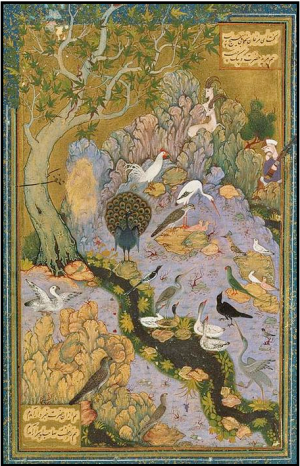
The Conference of the Birds
Qaf wouldn’t seem to be an inherently evil place, however. In the medieval Persian epic poem The Conference of the Birds, an allegory of the Sufi path toward enlightenment, a group of various birds seek out the mighty Simurgh[5] who resides at the top of Mount Qaf and who will, they hope, answer all their questions (a parallel book that might be more familiar to readers with knowledge of Christian tradition is Pilgrim’s Progress, written about 500 years after Conference). More than anything, Qaf seems unattainable to mere mortals. In some Muslim tellings of Alexandrian romances, apparently, Alexander the Great journeyed to Qaf, but if he did (and I’m not saying he didn’t), I would argue that:
- He is the exception that proves the rule
- He isn’t a good example of a “mere mortal” anyway
G. Willow Wilson imagines that jinn like places that humans have abandoned (“Detroit is popular.”) and that their “native” homes are simply “turned sideways” from our own view. It our human belief and perspective that denies us vision and experience of the place. Jonathan Stroud, who removes all religious context from his spirits but keeps their Arabic names in many cases, has them originating in the “Other Place.” This is perhaps a parallel dimension, but it is not a place that is conducive to human life. It is constant fluid movement and it is only there that Stroud’s spirits are comfortable. Drawn to our earth and enslaved here they are in constant, enervating discomfort. There is no suggestion that they can die in the Other Place, but they are very mortal when physical here. Perhaps it that “turning sideways,” to use Wilson’s phrasing, that helps create the conditions for jinn to be subject to capture by humans?
The Physical Manifestation of Jinn
The Qu’ran and hadith commentary suggest that jinn are often invisible or that they take the form of low or unclean animals (dogs and snakes). Folkloric sources may identify some evil mothers as ghouls. In my previous readings (and these were primarily in Inea Bushnaq’s Arab Folktales, to which I sadly do not have access as I write this), I had grown to align her “ghouls” with European “ogres.”[6] Bushnaq’s ghouls (my memory of them at any rate) terrorize those they encounter, whether their own children or people that wander into their domains. This current research into jinn, however, suggests the additional possibility that such ghouls are equally otherworldly. Part of the hurdle in making concrete identifications of how jinn can appear is their complexity and potentially contradictory taxonomy. One of my sources above (www.jinndemons.com) has ghouls and si’lah as male and female versions of the same essential creature. In her novel, Wilson has sila as primarily female shape-changers who are comfortable in human society and who are more dangerous than marids (not more powerful necessarily, but that in turn implies elevated intelligence).
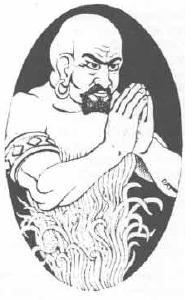
Dungeons and Dragons Djinni

Dungeons and Dragons Efreeti
The 1977 Dungeons & Dragons Monster Manual (my first introduction to something more than simply genies) identified djinn, efreet, and marids as mystical spirits originating from air, fire, and water respectively. Djinn tended toward the good, efreet were inherently evil (shaytan without saying so) and marids were the strongest and the most disregarding and contemptuous of humanity, but neither good nor evil. Catherynne Valente’s marids from her Fairyland series are blue and human-shaped, but they exist in a separate relation to time. The marid she introduces, Saturday, sees not only his child while he is still a child himself (The Girl Who Circumnavigated Fairyland) but also has a questionable relationship with one of his future incarnations (The Girl Who Soared Over Fairyland). Stroud’s spirits can take any shape whatsoever in our world, with the understanding that there are seven planes of existence in our world. If Bartimaeus wants to look like an Egyptian child wearing a leather jacket, that is how he will appear on the first plane, which is all humans can see without assistance. His essence, however, is fully revealed on the seventh plane, visible only to other higher spirits. Seventh plane manifestations are never described in the text but the implication is that they are more than the human mind can comprehend. The distinction he makes is that his spirits are fundamentally creatures of air and fire. Water and earth are anathema to them. Many visual representations of jinn fall back on simple exoticization: the male jinn are powerful with rippling muscles; the female jiniri have large breasts and wide hips. Costumes are similarly stereotypical, weapons optional. For unsurprising reasons, I’m looking at a wider range of presentation. They are not human, after all, and to show themselves in such shapes shows a rather limited imagination on their part – or perhaps, a rather limited imagination in our comprehension. In his short story “Hooves and the Hovel of Abdel Jameela,” Saladin Ahmed writes about a self-described “ghoul or demon” who is a composite creature in appearance and suffers no imaginary lack whatsoever – jackal-headed with goat hooves and a scorpion’s tale but whose voice is more beautiful than any woman’s could be. The main character, a physician can barely keep a hold on his sanity as he struggles to reconcile the physical presence of this creature in front of him.[7] The jinn of Wilson’s Alif the Unseen “turn sideways” to be more visible, but most humans still tend to look through them. Even when he does know who he’s dealing with, Alif struggles with a jinn’s talons and wings that suggest their presence without necessarily appearing.
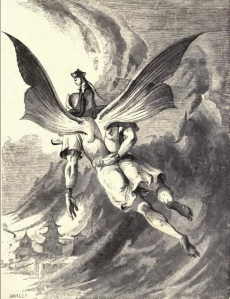
Aladdin and the Jinn
There is no shortage of other examples. One of the two title characters in Helene Wacker’s The Golem and the Jinni is bound into human shape by an enchanted iron bracelet. While he appears human for all intents and purposes to most people, a partially possessed man sees the Jinni for what he is, a burning shape trapped in this physical shape. The translation that I am reading of The Thousand Nights and One Night has jinn flying and taking different shapes but primarily looking like humans – though in their “natural” form they are never mistaken for humans. Robin Williams’ genie in Disney’s Aladdin (1992) is also a nimble shape-changer, and always blue. 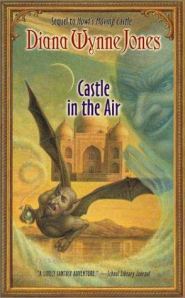 Diana Wynne Jones’ novel Castle in the Air showcases three spirits. The mighty Hasruel is gigantic and winged – very marid-like in his strength. His half-brother Dalzel is only half-djinni and his wings are smaller and ineffective. The main character finds a genie in a lamp, the third spirit, that can grant limited wishes but never through the manipulation of reality and instead typically through re-location (i.e. commanded to supply breakfast, the genie does so but it turns out that he stole the sultan’s meal). The genie is the only “ethereal” spirit, trapped in his lamp, whereas the other two djinn are not “spirits” in any sense. The Wishmaster horror film franchise showcases what is essentially a wish-granting demon from hell. The main variation? Tattoos and brands. (Tattoos also feature in Valente’s character Saturday and in a djinn in the webcomic Namesake)
Diana Wynne Jones’ novel Castle in the Air showcases three spirits. The mighty Hasruel is gigantic and winged – very marid-like in his strength. His half-brother Dalzel is only half-djinni and his wings are smaller and ineffective. The main character finds a genie in a lamp, the third spirit, that can grant limited wishes but never through the manipulation of reality and instead typically through re-location (i.e. commanded to supply breakfast, the genie does so but it turns out that he stole the sultan’s meal). The genie is the only “ethereal” spirit, trapped in his lamp, whereas the other two djinn are not “spirits” in any sense. The Wishmaster horror film franchise showcases what is essentially a wish-granting demon from hell. The main variation? Tattoos and brands. (Tattoos also feature in Valente’s character Saturday and in a djinn in the webcomic Namesake)
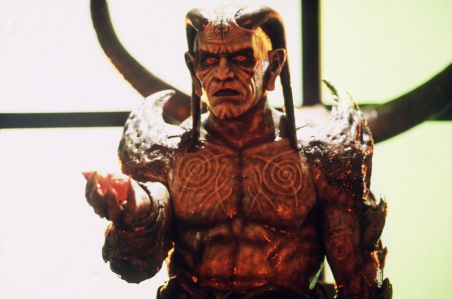
The Wishmaster Djinn
Created from smokeless fire and yet marids are comfortable in the ocean? Able to take the shapes of clay (humans)? All this, potentially, and greater power than humans but like humans in temperament, yet longer-lived. Which brings up the next point…
The Relationship Between Jinn and Humans
A rather different conception of the ghoul version of jinn appear in Saladin Ahmed’s novel The Throne of the Crescent Moon. Doctor Adoulla Makhsloodis a ghul hunter, though this title elides the truth somewhat. He does kill ghuls, to be sure, but here ghuls are more like golems. There are sand and water ghuls, flesh ghuls and earth ghuls. They are spirits that don’t so much take a particular shape as they are bound into a particular combination of materials. Given form by dark magic, they are difficult to destroy and it is questionable if they are actually killed. Doctor Makhslood is after the person who has animated these creatures. In the same sense that a physician must treat the symptoms of the disease and attack the infection at its source, Makhslood hunts the ghuls in order to hunt their masters. This relationship – that of control – is often at the crux of jinn and human interaction. First consider the intersection of power and position. Jinn were created second, after the angels, and humans third. Wilson’s jinn often refer to the main character Alif as either “cousin” or “third born,” for example. As a species, jinn are elder and therefore inherently deserving of more respect. Second, jinn are inherently more powerful than humans are. They can fly with no mechanical assistance. They are outrageously strong. They can change shape. Some can grant wishes. In these two ways, power and age, jinn should be superior to humans – and yet Allah placed humans above them. This is one source of unsurprising tension – stronger, elder siblings who resent the prestige and benefits granted to the younger. According to a handful of sources I read, the reason many jinn turned away from Allah was because he commanded them to bow to humans. Iblis, chief amongst the jinn, refused. He became the Devil, the figurehead at the forefront of all the shaytan who followed him.[8] A realted problem area is that of command. As a rule, jinn in folklore do not randomly slay their human cousins. They may be entranced by a human boy’s beauty and therefore transport him to be next to a human girl of equivalent beauty. They may masquerade as a woman and marry a man and cause him problems. They may be mischievous and cruel. They often threaten death, but they rarely carry it out. Contrast this with the fact that humans can enslave jinns. They may be contained in a lamp (Aladdin) or a bottle (I Dream of Jeannie – see also some episodes of the television show Charmed) or bound to an iron bracelet (The Golem and the Jinni) or some other physical object (Hasruel in Castle in the Air), or by mystical commands generally (the Bartimaeus novels). Given this juxtaposition, greater power cosmically placed at the mercy of a lesser power, you’d think there would be more antipathy from jinn toward us than simple disregard or general mischief. Iblis considered himself superior to humanity: “I am better than he; Thou didst create me from fire and him from clay.” (Sura 7:11-12). The shaytan react pretty much as you might expect, but not the rest of the jinn.
Clay and Fire and Inconsistency
Our base natures are what divide human and jinn. Could those natures motivate other aspects as well? In so many regards we are largely the same: free will, desire, love, hate, appetite, pain. Smokeless fire suggests purity to me – nothing is not burned in it. There is no waste. It is heat and light, weightless (or nearly so) and ever moving. Clay suggests damp earth, pottery, weight, something grounded. Clay is a medium for pottery, ceramics, brick-making, a material waiting to be shaped. Fire, contained, is a tool or a resource (fire for baking bread or for a forge). Uncontained fire is destruction. Clay is directed and given form. “Form” is not fire’s natural state. Clay is passive. Fire is active. Why should clay be superior to fire? Why should humans be elevated above jinn? Is it because the jinn’s smokeless fire is contained to begin with that they may be contained by us, their lesser cousins – that is, enslaved? Taken as a generic elemental force, the idea of fire-given-form is power held at bay. A water-based marid embodies the same two sides of power: life-giving, buoyant water and drowning undertows. Could it be that such spirits, originating in smokeless fire, embody any such tamed force?[9] Could there be spirits of air (as the Dungeons & Dragons djinni), spirits of electricity, of cold? Or are these latter spirits closer to the Greek daimones along with water-dwelling marids, chthonic spirits of a place, and the jinn are, properly speaking, closer to Stroud’s description, at home in the air and the fire and at danger in water and earth? The textual and literary record provides too many options for a clear and consistent taxonomy of jinn, though that perhaps is also a reflection of the nature of fire – inconsistently shaped, mercurial. Another possibility – clay can exist by itself but fire needs fuel. Yes, humans need food and drink to survive, while such basic necessities as sustenance seem rather beside the point in most writings about jinn. As purely as smokeless fire burns, it still needs a fuel. To me, that is the greatest mystery of jinn. Not the enslavement, not the shape-changing, not being “turned sideways.” No: what keeps them from being extinguished?
================================
Footnotes
[1] It’s tempting to take “genie” as a corruption of “jinni,” but in fact the former is a fairly direct translation of the Latin genius, which is in turn the translation of the Greek daemon. English translations of The Arabian Nights followed the French genie rather than the Arabic original. Language! Crazy! [2] Confusingly for me, apparently jinn is the plural and jinni is the singular. I’m used to my plurals having more letters/sounds than my singulars. The bias of language! [3] These sources are called hadith. As I understand them, hadith are supplementary writings connected to the Qu’ran and its study that have varying degrees of import depending on a variety of factors, including the particular branch of Islam and the authority of the hadith’s author, for example [4] Iblis was of great enough stature that he was considered to be on par with the angels. They angels could not and would not rebel because they were not created with free will, not like jinn and humans. Free will is the blessing and the curse that separates us from divinity. It can bring us toward divinity or it can lead us away. This is true for both of us free-willed, independent cousins. [5] For some reading on the Simurgh, see this Bestiary entry on Roc, its closest counterpart. [6] I should say that my understanding of “ogre” is not the Dungeons & Dragons beast, larger than a human and smaller than a giant. Instead, my understanding has shifted to be a brutish man (almost always a man) with cruel and cannibalistic tendencies. They tend to be more cunning than smart. Not to get too far out on a tangent, but consider the difference between someone like Bluebeard (ogrish) and Hansel and Gretel’s witch. Their characters are very similar, but Bluebeard is a rich “noble” while the witch has mystical powers. The former is more analogous to an ogre and the latter more to a jinn via her magic, though being very this-world (like Bluebeard) keeps her from moving much closer. Arab folklore also has sorcerers, so there’s no need to stretch this analogy any further. [7] The main character’s psychic suffering is positively Lovecraftian – which I don’t mean to reflect upon the writing and tenor of the story so much as the threshold of madness that the physician approaches. [8] There are several films that play on the power of shaytan – the Wishmaster series (1997,1999,2001,2002) about a jinn that grants wishes that he twists and corrupts; Djinn (2013); Jinn (2014). Don’t think this represents the end of the list of such films. [9] Note: tamed only; never domesticated.
================================
Other Sources
While these other webpages are not ones I cite directly in the article above, they may be of further interest. In no particular order: http://cryptidz.wikia.com/wiki/Jinn http://mythicalbeasties.blogspot.com/2008/09/d-for-djinn.html http://namesakecomic.com/wp-content/uploads/2013/08/Chapter15_36.jpg http://wendyjargonncom.blogspot.com/2013/11/the-djinn.html http://www.allposters.com/-sp/Aladdin-and-the-Djinn-Posters_i6740840_.htm?aid=1630434966&LinkTypeID=1&PosterTypeID=1&DestType=7 http://www.occultopedia.com/j/jinn.htm http://en.wikipedia.org/wiki/Jinn#Etymology_and_definitions http://paranormal.about.com/od/demonsandexorcism/a/aa060506_2.htm

